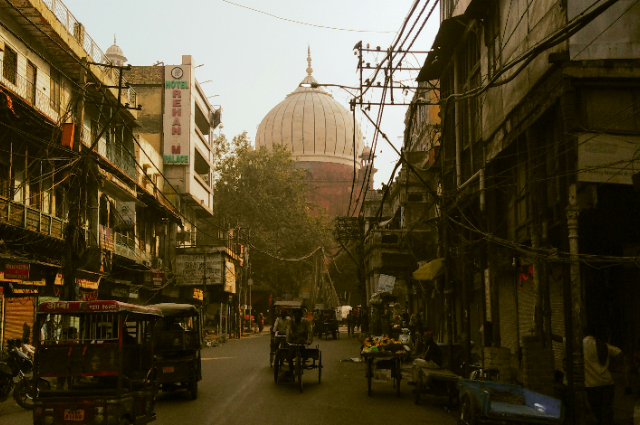
Photo by HF on Unsplash
Walking through Old Delhi and the crowded lanes of Chandni Chowk in the evening, I found myself surrounded by a chaotic mix of development and traditions. The honking of vehicles, the chatter of shopkeepers, and the glow of neon signs painted a picture of modernization. While the building, the food, the place itself felt old. Yet, as I glanced around, something felt missing, something I hadn’t thought about in years. Then, in a distance within a shop among the vibrant displays of candies and chocolates, I spotted a glossy lollipop. It wasn’t quite what I was looking for or missing, but it reminded me of a piece of my childhood; the Bombay Meethai, the soft, sugary treat I used to buy as a child.
Back then, an old uncle would arrive in our neighborhood with a block wrapped in that sugary treat, which he would shape into different designs, as we kids demanded. I would wait eagerly after school, sometimes helping my mother with house chores for a few extra coins to buy an extra piece. But now, no matter how much I search, online or offline, I can't seem to find it anymore. It feels like a small yet significant part of my childhood has vanished, much like many other traditional aspects of life in India.
The Disappearance of Traditional Professions
Much like Bombay Meethai and many other candies, countless professions have faded into history, quietly replaced by modernization. Take the Rudaalis, the professional mourners of Rajasthan. They once had an important job, of expressing grief in households where mourning out loud was considered inappropriate. But with changing social norms, they are now almost nonexistent.
Then there’s the khaat, the traditional wooden and rope bed that once was in every village courtyard. Comfortable, breathable, and handcrafted with skill, it was more than just a piece of furniture, it was a symbol of rural life. Today, factory-made beds and sofas have taken over, and khaats are seen as relics of the past, appearing only in nostalgic village stories, or in conversation of nostalgia.
Handicrafts have suffered a similar fate. Artisans who once wove, painted, and carved with precise detail are now struggling, as they do not have the name of the brand behind them. While people admire handcrafted goods, and click their pictures, they rarely buy them for house decoration, choosing mass-produced, factory-made alternatives instead. The respect for craftsmanship remains, but the willingness to support it financially has reduced.
The Rise of Big Companies and the Loss of Local Markets
It’s not just candies, or some small professions that are disappearing, but entire local markets are changing. The small family-run businesses that thrived for generations are now struggling to survive against corporate giants. The personal touch of a shopkeeper who knew your tastes has been replaced by algorithm-driven online recommendations. The scent of freshly ground spices in a local kirana store now competes with neatly packaged, multinational brands displayed in air-conditioned supermarkets.
Even culturally, traditions are shifting. The music and visuals of old Bollywood that once reflected the warmth of Indian heritage are now archived in YouTube playlists, buried under the modern digital content. What made the childhood of almost a whole generation has turned into nothing but memories.
Reels and short-form videos often remix nostalgia, but do they truly preserve it, or simply repurpose it for fleeting trends?
A Digital Lifeline for the Past
Despite so many traditional art works or classic words declining, some traditions have found new ways to survive. Many artisans and small businesses have turned to the digital world, selling their crafts through Instagram, Etsy, and WhatsApp groups. They have adapted, using reels and social media to attract clients, who might never have walked into their shops otherwise. Some succeed, reviving their art in new ways, but many others struggle, especially those without the means or knowledge to transition into this fast-paced digital economy. Those who didn't succeed in it had lost the war of digitalization.
For every success story, there are countless silent disappearances. Many skills and crafts have been lost, not because they lacked value, but because no one remained to carry them forward. What happens to traditions when there is no one left to perfect them?
Preserving More Than Just Memories
The nostalgia isn't just about longing for the past, and the traditions we have lost, it's also about remembering what we have let slip away from our own hands. The smell of fresh Bombay Meethai, the sight of a khaat in the courtyard, the sound of an old folk song playing on a radio, these aren’t just memories, they are fragments of a culture slowly fading in the noise of modernity.
So, how much of our past do we truly preserve, and how much do we just romanticize? The answer might lie in our actions. Do we make an effort to support local artisans, seek out traditional foods, and pass down these small but meaningful aspects of culture? Or do we simply scroll past nostalgia-themed posts, remembering for a moment before moving on?
As I left Chandni Chowk that day, I couldn’t help but wonder, how many other childhood memories have been lost to time? And more importantly, how many are still waiting to be heard, to be saved?
